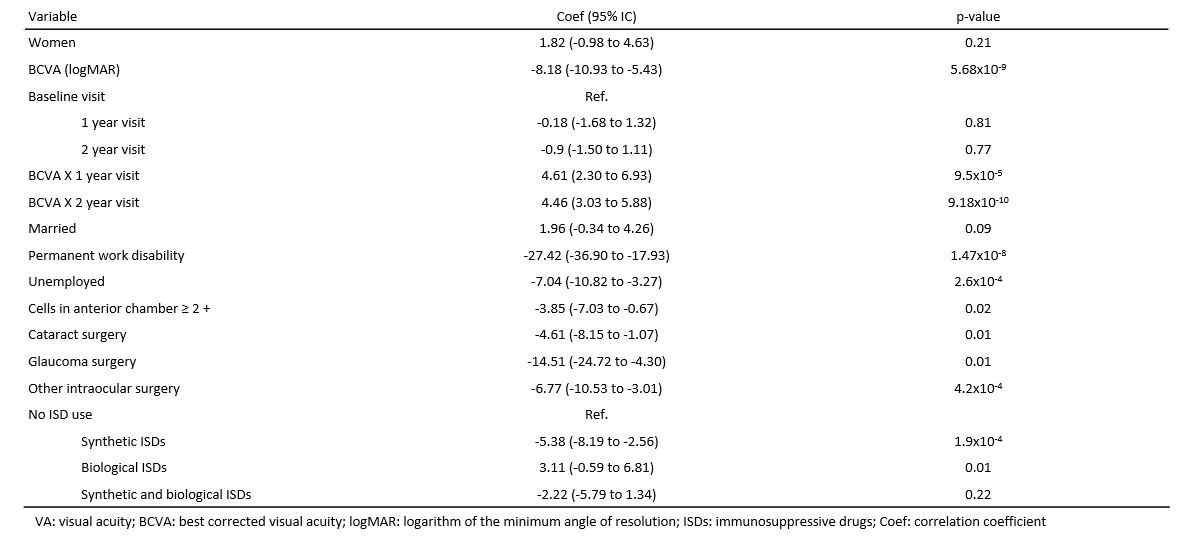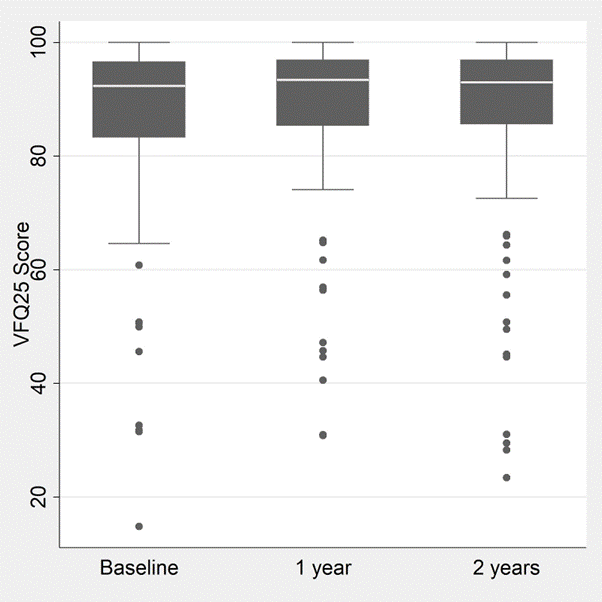Session Information
Date: Monday, November 13, 2023
Title: (1124–1154) Miscellaneous Rheumatic & Inflammatory Diseases Poster II
Session Type: Poster Session B
Session Time: 9:00AM-11:00AM
Background/Purpose: Non-infectious uveitis (NIU) are characterized by inflammation of the middle layer of the eye wall and have a significant impact on patients’ visual-related quality of life (VRQoL). Objective measures of vision, such as visual acuity, do not fully account for the impact of these diseases on the patients’ perceived QoL, as it includes other relevant and important aspects not evaluated in routine clinical practice. The assessment of the patient’s QoL through standardized and validated questionnaires allows us to evaluate objectively the actual burden of the disease. Several cross-sectional studies have shown that the VRQoL of NIU patients is reduced. However, the evidence regarding how QoL evolves in real life clinical practice and what characteristics influence this evolution is scarce. Therefore, our objective is to describe the evolution of the VRQoL in subjects with NIU and to identify factors associated with increased or decreased VRQoL during follow-up.
Methods: Prospective longitudinal observational study including consecutive NIU patients from a tertiary uveitis clinic from Madrid (Spain). Main outcome was the composite score of the Visual Functioning Questionnaire 25 (VFQ25), measured at baseline and after 1 and 2 years of follow-up. Influence of demographic, clinical, and treatment-related variables (assessed at the same time points) in repeated measures of VRQoL was analyzed using bivariable and multivariable generalized estimating equations (GEE) models nested by patient.
Results: One hundred and forty five patients were included in the analysis, with 422 visits. In the two years of follow up, no significant changes were observed in the evolution of the VFQ25 (Figure). In the multivariate analysis, lower best corrected visual acuity, presence of permanent work disability, being unemployed, cells in anterior chamber ≥2+, previous cataract surgery, previous glaucoma surgery, other intraocular surgeries, and prescription of synthetic immunosuppressive drugs were independently associated with lower VFQ25 (Table).
Conclusion: In the two years follow-up of our study, we did not identify significant changes in the evolution of the VRQoL in NIU patients. Nevertheless, we found some social factors that could contribute to a decreased VQ25 during follow-up. Essentially, work status and financial well-being. Clinical variables were also identified, such as lower visual acuity and factors that might reflect active disease (cells in anterior chamber ≥2+ and prescription of synthetic immunosuppressive drugs). We also detected that previous ocular surgery might contribute to a lower VQ25 score. This preliminary data allows us to evaluate other variables that contribute to the burden of the disease and the extent of the patient’s suffering regarding their vision and reflect the importance of identifying them to improve our patients’ quality of life.
To cite this abstract in AMA style:
Alvarez Hernandez M, Pérez Sancristóbal I, Madrid García A, Borrego Sanz L, Hormigos martín C, García Tirado B, Ariño Gutiérrez M, lajas Petisco C, Arriola Villalobos P, Pato Cour E, Rodríguez Rodríguez L. Factors Associated with Vision-Related Quality of Life in Patients with Non-infectious Uveitis: A Longitudinal Analysis [abstract]. Arthritis Rheumatol. 2023; 75 (suppl 9). https://acrabstracts.org/abstract/factors-associated-with-vision-related-quality-of-life-in-patients-with-non-infectious-uveitis-a-longitudinal-analysis/. Accessed .« Back to ACR Convergence 2023
ACR Meeting Abstracts - https://acrabstracts.org/abstract/factors-associated-with-vision-related-quality-of-life-in-patients-with-non-infectious-uveitis-a-longitudinal-analysis/


